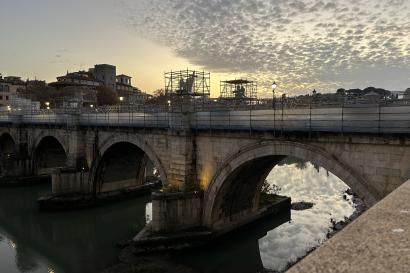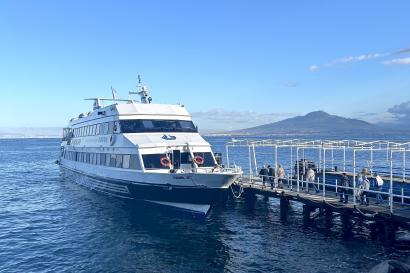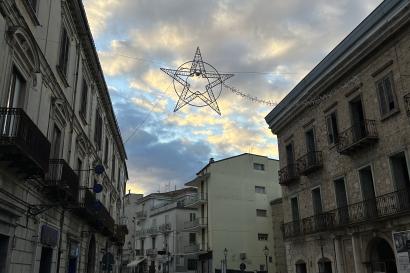One-hundred days. I have kept a journal during my time in Rome and Wednesday, May 11th marks the 100th day that I have spent abroad. In a way it feels like the trips I took recently happened further back than my arrival. I got to Rome only yesterday, but Dublin was so long ago. Time has a strange way of working like that. In a city that has existed for thousands of years in some form, the effects of time are all around you. We like to point out the monuments or old-school roads, but Trajan’s column has stood in its spot in the forum long before us and may remain long after we are gone. Yeah, that might be a little existential and a downer, but that also means there is so much cool stuff around us waiting to be found. So, for my 100th day abroad, I decided to talk about my two favorite spots in Rome: the Capitoline hill museum and the Aurelian walls. These two places, to me at least, summarize what I love about Rome, and I hope to explain why.
First, the Capitoline hill museum. This is a museum on a hill, which narrows down its location in Rome very little. You can find this spot near the forum, on top of a hill next to a church. Ok, a little narrower. The most significant indicator of the museum is the statue of the Roman emperor Marcus Aurelius upon a horse. IES Abroad was kind enough to give all the students a MIC card, which allows free access to a group of museums in the city, including this one. The first major indication that this is going to be an insane museum is the courtyard just past the entrance. This courtyard features the head, feet and arms of the Roman emperor Constantine. I have seen the photos on Wikipedia they use for Constantine, and it is the bust. What I did not know was how huge the bust of his face was. The few body parts they have on display speak to the sheer scale the original statue must have contained.
The museum is divided into a few floors, and because things are different in Europe it goes from level -1 to 2 (-1,0,1,2). The negative floor is a hallway full of epitaphs, descriptions, military orders, anything written by anyone in Rome, all on stone tablets. It may seem mundane but knowing what daily life was for someone at that time is an aspect of history I need to explore more of. Additionally, there is an underground room that contains the original statue of Marcus Aurelius on a horse, the one built during his reign. These equestrian statues were common for Roman emperors, but only the one of Marcus Aurelius survives today. The bottom floor contains much more but if I were to list everything I saw, this would take days. The zero floor contains statues to many Roman Gods as well as a beautiful statue which honestly is par for the course for all other fountains in Rome. The first floor contained my favorite room, the room of the emperors. This room featured busts of almost every Roman emperor, from Augustus all the way to Caracalla and beyond. Some of the late Roman emperors do not have busts but the room was covered wall to wall with them. I have seen busts of Trajan and Marcus Aurelius so many times it is like seeing a stock image.
The rest of the museum contained many more treasures, such as a pristine statue of the Dying Galatian, a small Egyptian section and much more I can only remember through the photos I took. I love free-roaming museums, and this was everything I dreamed of. This period of history is one of my favorites and it is hard to describe the feeling of being surrounded by so many fascinating looks into what things were like. No living historian can ever truly know how the people of the Roman empire lived like, we can map it out, but we will never truly understand. A few more simple reasons why I loved this museum so much are: 1) I love history 2) It was free 3) Rome! I was in awe the whole time I was there and can easily say it is my favorite museum I have ever had the pleasure of visiting. If I ever return to Rome, I shall be stopping by without a doubt.
If you have read my previous blog about Rome (thanks if you have), then you might remember I have already talked about the Aurelian walls. My reasons for loving it then are the same as now. A museum can provide an excellent experience as everything is organized for you to explore, but there is nothing like being able to stand in front of massive fortress walls, that have stood the test of the centuries. I decided to visit them again, and much to my joy, there was a small banner and door indicating there was a museum inside the wall to visit. Inside the wall! And the best part is free admission for everyone! I was intrigued so I stepped inside and grabbed a ticket. It is by no means a big museum, there is not even that much on display. A few mosaics here, a timeline of how the wall was built there, cool stuff but nothing that pulled me in. That was until I opened a door at the end of the hall and was greeted with something truly wonderful. You can walk inside the walls. For a good distance you are able to walk inside of the battlements, seeing the little holes in the wall where archers could have put their bows, holes where you can stick your head out and get a sense of scale. There was even a cat! And the most bizarre thing was behind the wall were some small houses and gardens. That is where the effects of time come back into the mix. The Aurelian walls are ancient, and they have remained, overgrown with flowers overlooking roads while protecting gardens. To really put the cherry on top, you can climb on top of one of the large towers and get a view of the city. Even in the rain, it was a sight to behold.
So, that was Rome. I ate some good food, met some cool people and walked along a wall. I mean I did more but those are definitely the highlights. And now I go home, and for once will be able to eat some non-Italian food if I choose. Strange. To end the blog, I wanted to write about the first experience I had walking to the top of the Capitoline hill and seeing the statue of Marcus Aurelius. It was the first week in Rome, during one of the IES Abroad orientation events. It was during a neighborhood tour where we walked up the hill. Our Italian student companion tour guide was telling us something about the statue, but I was not paying attention. Instead, I was just looking at the statue. It was not even the original statue but yet it depicted a man. The emperor of a long dead empire, commemorating a deed I did not know. That emperor overlooked the city, a city which was the heart of an empire that stretched from the edges of Scotland to the mountains of Armenia. It had been there long before me, and Marcus Aurelius is still there, watching. Overlooking the same city. Roma.

Ian Donahue
Hey! My name is Ian and I am a junior at Ithaca College, where I major in history meaning long papers are my specialty. I play on my school's club ultimate frisbee team and we even went to the national tournament! I am from New York City so navigating public transit is a refined skill of mine. I am beyond excited and grateful for the opportunity to study abroad in Rome, eat amazing food and see places I've dreamed of seeing my whole life.








